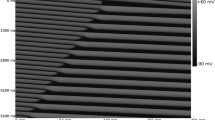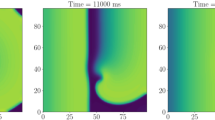Summary
We discuss computer simulations of one- and two-dimensional excitation waves corresponding to normal and abnormal rhythms in a model of myocardium. Our studies are aimed at finding the major physiologic parameters governing such transient processes as the formation of a reentrant wave and its subsequent degradation into the malignant cardiac arrhythmia – ventricular fibrillation. Our results demonstrate that in both the one- and two-dimensional cases the stability of a periodic process (representing a regular or VT rhythm) is determined by the same two physiologic parameters: the wavewidth , which is approximately is the width of depolarized zone, and ratio of to the critical length , which is defined as the wavewidth of an action potential propagating with the minimum possible speed. The amazing feature of general excitable medium is that these two numbers play predominate role in determining the behavior of the system. The parameter determines the length scale (size) of an ectopic region that may initiate a wave. It also determines the duration of the vulnerable window for initiating the unidirectional block as well as a minimum permissible length of the reentrant circuit. In two dimensions the relation between the diameter of the spiral core and the value of determines the pattern of spiral tip motion (near circular versus meandering) as it represents the outcome of the balance between electrical sources from depolarizing membrane and the electrical sinks (diffusive, i.e. Ohmic fluxes). This balance controls in a similar way two important electrophysiologic processes, the separation of a spiral tip from unexcitable obstacle (scar tissue) and the transition to meandering of the spiral tip in the homogeneous 2D medium. We also present some evidence that depending on the value of the waveforms of the simulated ECGs for reentrant activity vary from monomorphic to polymorphic.
Similar content being viewed by others
Author information
Authors and Affiliations
Additional information
Received: 1 March 1999 Accepted after revision: 6 April 1999
Rights and permissions
About this article
Cite this article
Starobin, J., Chernyak, Y. The role of a critical excitation length scale in dynamics of reentrant cardiac arrhythmias. Herzschr Elektrophys 10, 119–136 (1999). https://doi.org/10.1007/s003990050054
Issue Date:
DOI: https://doi.org/10.1007/s003990050054




